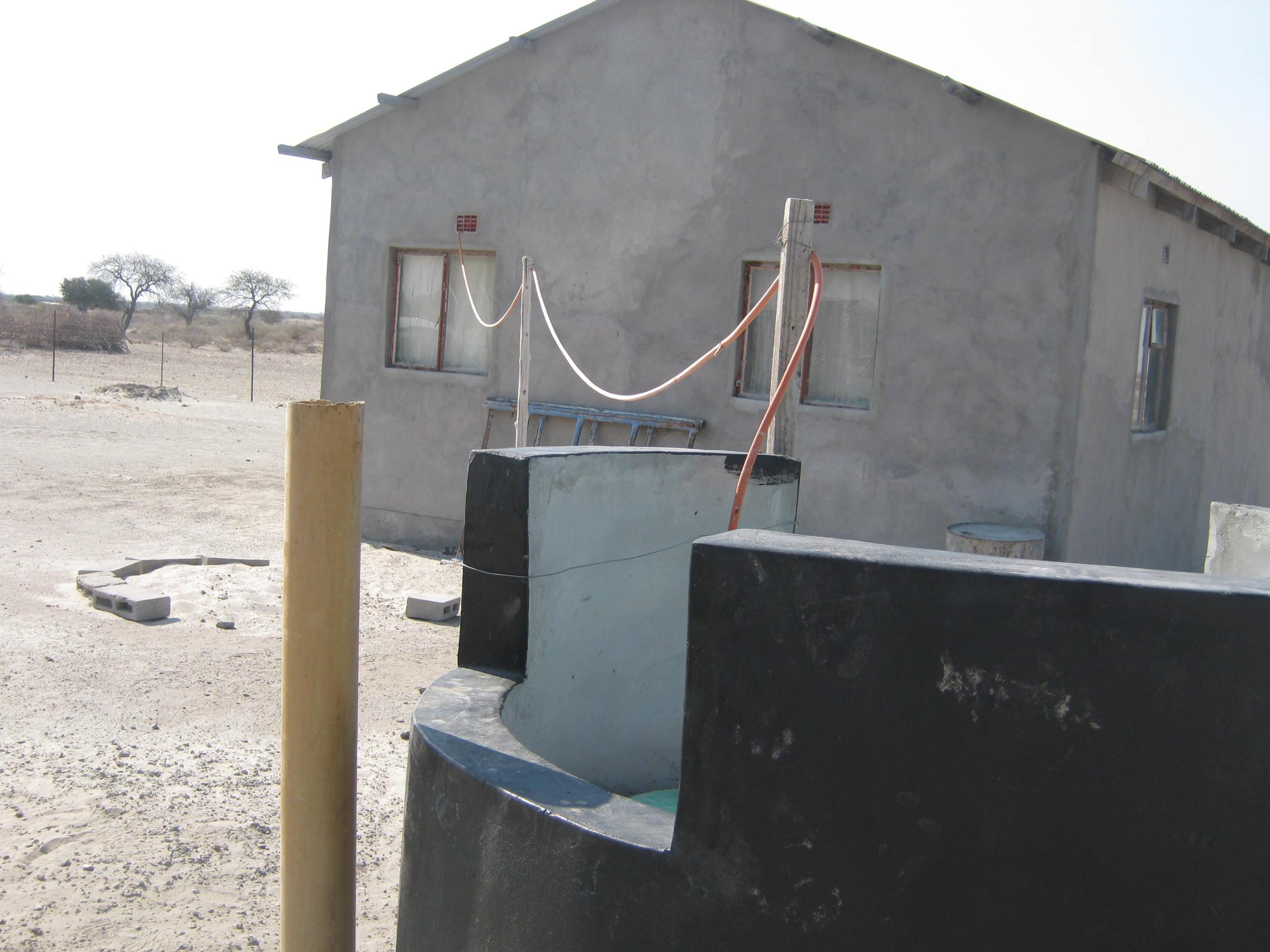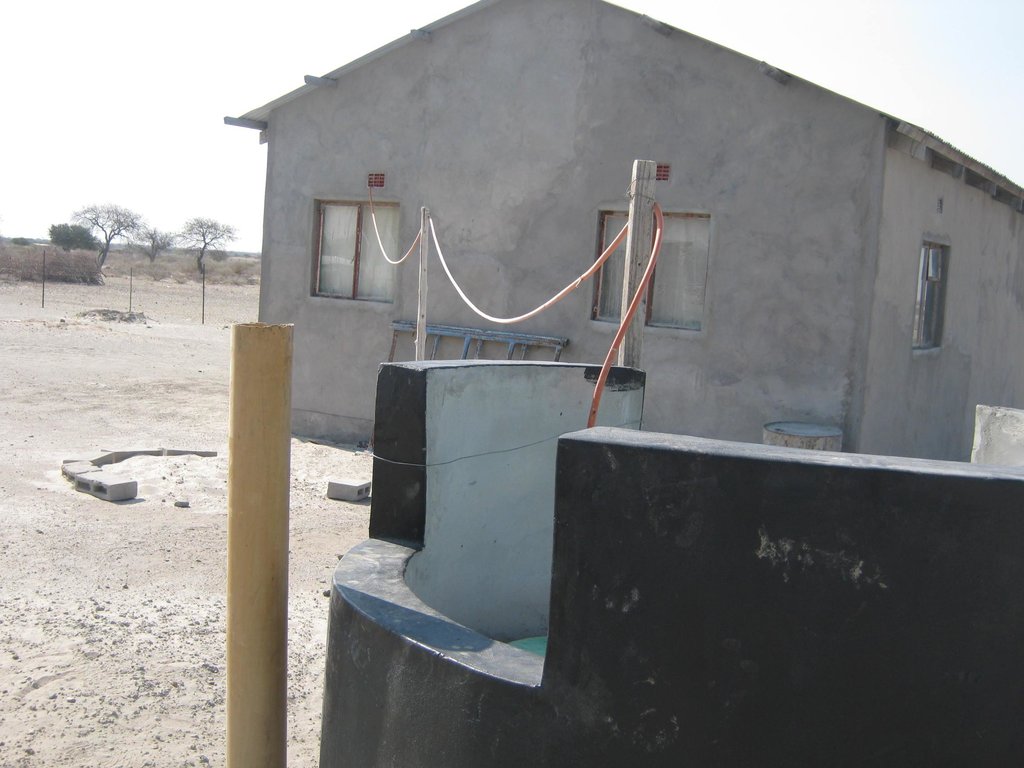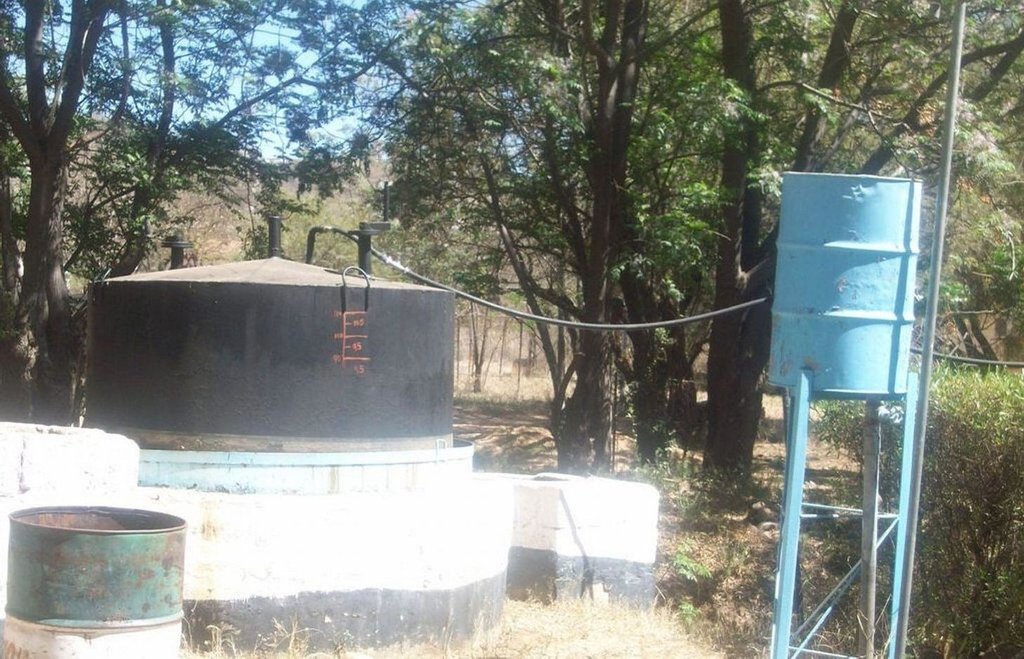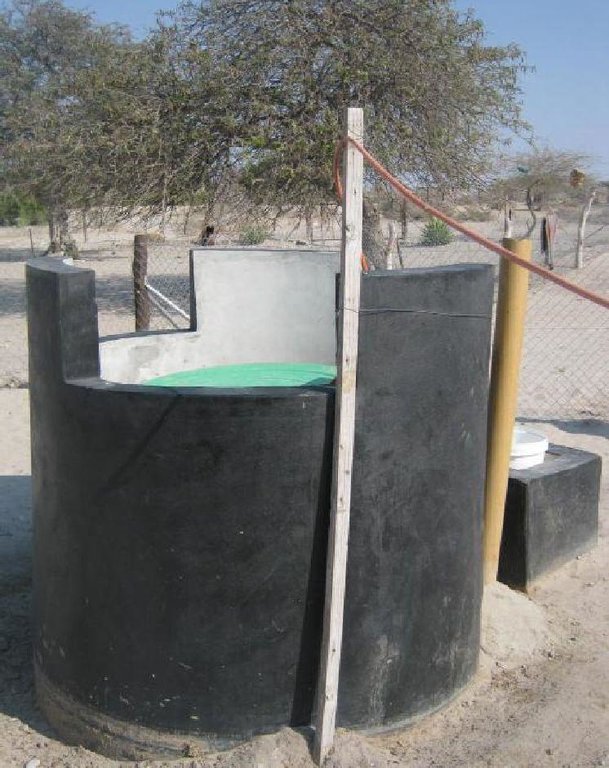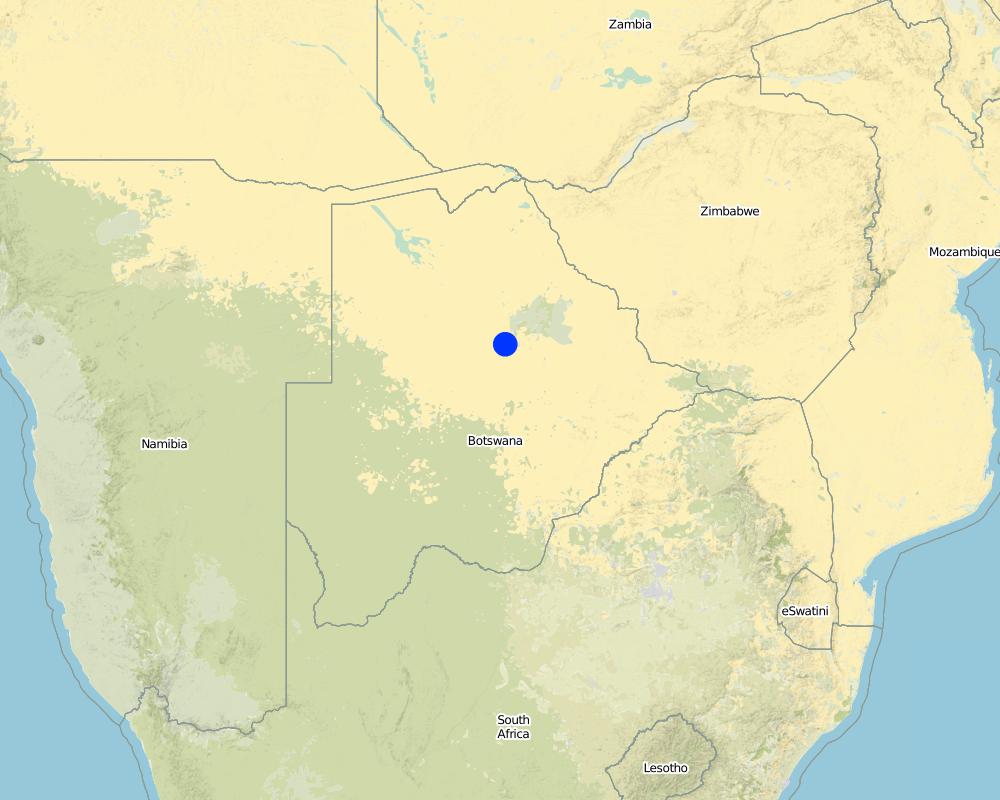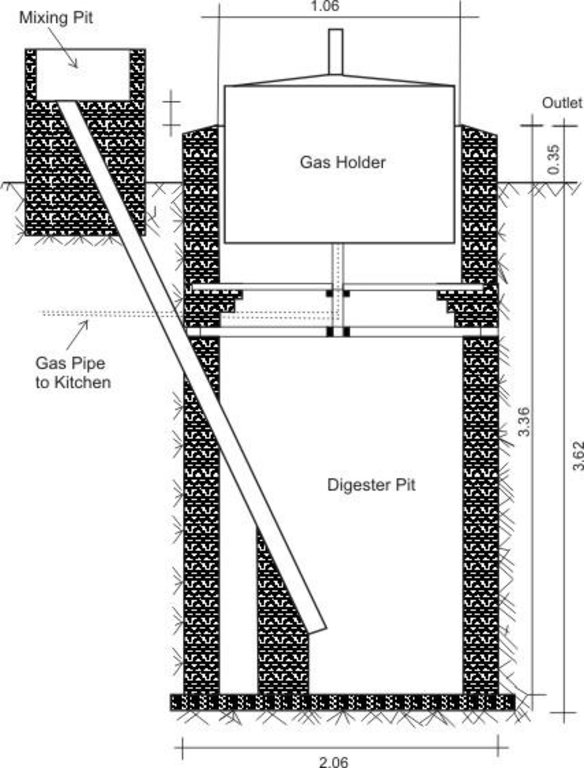Biogas [ប្រទេសបុតស្វាណា]
- ការបង្កើត៖
- បច្ចុប្បន្នភាព
- អ្នកចងក្រង៖ Sebego Reuben
- អ្នកកែសម្រួល៖ –
- អ្នកត្រួតពិនិត្យច្រើនទៀត៖ Fabian Ottiger, Alexandra Gavilano
Gase ya Boloko (Setswana)
technologies_1521 - ប្រទេសបុតស្វាណា
ពិនិត្យមើលគ្រប់ផ្នែក
ពង្រីកមើលទាំងអស់ បង្រួមទាំងអស់1. ព័ត៌មានទូទៅ
1.2 ព័ត៌មានលម្អិតពីបុគ្គលសំខាន់ៗ និងស្ថាប័នដែលចូលរួមក្នុងការវាយតម្លៃ និងចងក្រងឯកសារនៃបច្ចេកទេស
អ្នកជំនាញឯកទេស SLM:
Mulale Kutlwano
ប្រទេសបុតស្វាណា
អ្នកជំនាញឯកទេស SLM:
Chanda Raban
University of Botswana
ប្រទេសបុតស្វាណា
ឈ្មោះគម្រោងដែលបានចងក្រងឯកសារ/ វាយតម្លៃលើបច្ចេកទេស (បើទាក់ទង)
DESIRE (EU-DES!RE)ឈ្មោះអង្គភាពមួយ (ច្រើន) ដែលបានចងក្រងឯកសារ/ វាយតម្លៃបច្ចេកទេស (បើទាក់ទង)
University of Botswana (University of Botswana) - ប្រទេសបុតស្វាណា1.3 លក្ខខណ្ឌទាក់ទងទៅនឹងការប្រើប្រាស់ទិន្នន័យដែលបានចងក្រងតាមរយៈ វ៉ូខេត
អ្នកចងក្រង និង(បុគ្គលសំខាន់ៗ)យល់ព្រមទទួលយកនូវលក្ខខណ្ឌនានាទាក់ទងទៅនឹងការប្រើប្រាស់ទិន្នន័យដែលបានចងក្រងតាមរយៈវ៉ូខេត:
បាទ/ចា៎
2. ការពណ៌នាពីបច្ចេកទេស SLM
2.1 ការពណ៌នាដោយសង្ខេបពីបច្ចេកទេស
និយមន័យបច្ចេកទេស:
Production of methane gas from cow-dung for use in house-hold cooking, heating and lighting in order to reduce fire wood demand
2.2 ការពណ៌នាលម្អិតពីបច្ចេកទេស
ការពណ៌នា:
Biogas plant: The biogas plant can be constructed in several ways as long as it can provide a medium for the biological material be digested. Biogas is the name given to the gas that is produced during the decomposition of some organic waste specifically to produce methane gas. The gas is then captured in a storage tank (on site) to be used for household energy needs. In many parts of the world where this technology is used (including Botswana) the most common form of input material is cow dung making it more appropriate for rural environments.
Purpose of the Technology: Advantages: the technology offers two major advantages; first, at every level of use i.e. individual or institutional, savings in terms of energy is realized. The only costs that are borne are at installation, otherwise input of cow dung has a minimal cost of collection (if any at all). The second advantage is that there is reduced usage of fuel wood which translates into less cutting down of trees leading to reduced deforestation and degradation of land. A disadvantage is the initial investment which is significant for poor farmers.
Establishment / maintenance activities and inputs: Construction of the biogas plant: construction of the plant consists of three main chambers: namely, the Digester pit where all the microbiological reactions or decomposition of the material takes place. The digester has to be built to be air-tight with the released gas only escaping into the gas holder. The gas holder is connected to the digester by way of a pipe. Its main purpose is to collect all the gas that has been fermented. The mixing pit is the input chamber where the dung is mixed with water and fed into the digester. The amount and quality of water required for this is no constraint, even in this water stressed area. Construction the biogas plant has to be done according to specifications. A technical drawing of the plant is shown on page 3. The purpose of the technology is to use it for house-hold energy (for cooking, lighting and running appliances).
Natural / human environment: In Botswana the technology was introduced by the Rural Industries Innovation Center which is a government funded research institution. Despite the existence of this company for many years, the uptake has been very low due to poor marketing and extension services and lack of financial assistance to poor farmers.
Biogas is suitable either for a farm, cattle post or rural setting where the inputs (cow dung) are easily available. But there are possibilities of experimenting with other bio-degradable materials in major centres where cow dung is not readily available.
2.3 រូបភាពនៃបច្ចេកទេស
2.5 ប្រទេស/តំបន់/ទីតាំងកន្លែង ដែលបច្ចេកទេសត្រូវបានអនុវត្ត និងបានគ្រប់ដណ្តប់ដោយការវាយតម្លៃនេះ
ប្រទេស:
ប្រទេសបុតស្វាណា
តំបន់/រដ្ឋ/ខេត្ត:
Southern District
បញ្ជាក់បន្ថែមពីលក្ខណៈនៃទីតាំង:
Kanye village
បញ្ជាក់ពីការសាយភាយនៃបច្ចេកទេស:
- អនុវត្តនៅកន្លែងជាក់លាក់មួយ/ ប្រមូលផ្តុំនៅតំបន់តូចៗ
មតិយោបល់:
Total area covered by the SLM Technology is 0 km2.
This technology is basically on a point location, even though it is to benefit a wider area in terms of conservation
Map
×2.6 កាលបរិច្ឆេទនៃការអនុវត្ត
ប្រសិនបើមិនច្បាស់ឆ្នាំ សូមបញ្ជាក់កាលបរិច្ឆេទដែលប្រហាក់ប្រហែល:
- 10-50 ឆ្នាំ
2.7 ការណែនាំពីបច្ចេកទេស
សូមបញ្ជាក់តើបច្ចេកទេសត្រូវបានណែនាំឱ្យអនុវត្តដោយរបៀបណា:
- តាមរយៈគម្រោង / អន្តរាគមន៍ពីខាងក្រៅ
មតិយោបល់ (ប្រភេទនៃគម្រោង ។ល។):
The technology is promoted by a government funded NGO, but has its origins outside the country
3. ចំណាត់ថ្នាក់នៃបច្ចេកទេស SLM
3.1 គោលបំណងចម្បង (១ ឬច្រើន) នៃបច្ចេកទេសនេះ
- កាត់បន្ថយ, បង្ការ, ស្តារឡើងវិញនូវការធ្លាក់ចុះគុណភាពដី
- អភិរក្សប្រព័ន្ធអេកូឡូស៊ី
- បង្កើតផលប្រយោជន៍សេដ្ឋកិច្ច
3.2 ប្រភេទដីប្រើប្រាស់មួយប្រភេទ (ច្រើនប្រភេទ) ដែលបានអនុវត្តបច្ចេកទេស
ដីប្រើប្រាស់ចម្រុះនៅលើដីតែមួយ:
បាទ/ចា៎
បញ្ជាក់ពីប្រភេទដីច្រើនប្រភេទ (ដីដាំដំណាំ/ដីចិញ្ចឹមសត្វ/ដីព្រៃឈើ):
- ដាំដំណាំ ចិញ្ចឹមសត្វ និងឈើ

ដីដាំដំណាំ
ចំនួនសារដែលដាំដំណាំក្នុងមួយឆ្នាំ:
- 1
សូមបញ្ជាក់:
Longest growing period in days: 179 Longest growing period from month to month: Oct - Mar

ដីសម្រាប់ចិញ្ចឹមសត្វ
វាលស្មៅធំៗ:
- ពាក់កណ្តាលពនេចរ
ប្រភេទសត្វ:
- សត្វពាហនៈ - សត្វចិញ្ចឹមមិនយកទឹកដោះតែសម្រាប់យកសាច់
- សត្វពពែ
- សត្វលា
- បសុបក្សី
- សត្វចៀម

ដីព្រៃ/ដីដាំដើមឈើ
ផលិតផល និងសេវាកម្ម:
- អុស
- ផ្លែឈើ និងគ្រាប់ធញ្ញជាតិ
- វាលស្មៅ
មតិយោបល់:
Major land use problems (compiler’s opinion): Overgrazing of the commons, droughts, saline water and over-harvesting of fuelwood for cooking, heating leading to deforestation and land degradation
Major land use problems (land users’ perception): Overgrazing of the commons, droughts, saline water and over-harvesting of fuelwood for cooking, heating leading to deforestation and land degradation.
Grazingland comments: Biogass technology is not applied in the Boteti area at the moment, only at DESIRE test site.
Selective felling of (semi-) natural forests: specific tree species are felled for fuelwood even though people are supposed to take only fallen-dead wood
Type of cropping system and major crops comments: Mixed cropping is the traditional practice but government extension advice promotes monocropping which the majority find expensive and risky.
Type of grazing system comments: Biogass technology is not applied in the Boteti area at the moment, only at DESIRE test site.
Constraints of settlement / urban
Livestock density: 1-10 LU /km2
3.4 ការផ្គត់ផ្គង់ទឹក
ការផ្គត់ផ្គង់ទឹកនៅកន្លែងអនុវត្តបច្ចេកទេស:
- ទឹកភ្លៀង
មតិយោបល់:
Water supply: Also post-flooding
3.5 ក្រុម SLM ដែលបច្ចេកទេសស្ថិតនៅក្នុង
- បច្ចេកទេសប្រើប្រាស់ថាមពលមានប្រសិទ្ធភាព
3.6 វិធានការ SLM ដែលបញ្ចូលនូវបច្ចេកទេស

វិធានការរចនាស័ម្ពន្ធ
- S11: ផ្សេងៗ

វិធានការគ្រប់គ្រង
- M2: ការផ្លាស់ប្តូរការគ្រប់គ្រង/ កម្រិតអាំងតង់ស៊ីតេ
មតិយោបល់:
Main measures: management measures
3.7 កំណត់ប្រភេទនៃការធ្លាក់ចុះគុណភាពដីសំខាន់ៗដែលបច្ចេកទេសនេះបានដោះស្រាយ

ការធ្លាក់ចុះជីវសាស្ត្រនៃដី
- Bc: ការថយចុះនូវគម្របរុក្ខជាតិ
- Bs: សមាសភាពដែលមានគុណភាពនិងប្រភេទសត្វ/ការថយចុះនូវជីវចម្រុះ
មតិយោបល់:
Main type of degradation addressed: Bc: reduction of vegetation cover, Bs: quality and species composition /diversity decline
Main causes of degradation: deforestation / removal of natural vegetation (incl. forest fires) (harvesting of fuelwood for cooking, sometimes live trees are harvested.), land tenure (Area is communal grazing land)
Secondary causes of degradation: over-exploitation of vegetation for domestic use (Trees are cut for bush fences), droughts (The study area is prone to droughts), poverty / wealth ((lack of alternative livelihood sources))
3.8 ការពារ កាត់បន្ថយ ឬស្តារឡើងវិញនៃការធ្លាក់ចុះគុណភាពដី
បញ្ជាក់ពីគោលដៅរបស់បច្ចេកទេស ដែលផ្តោតទៅការធ្លាក់ចុះគុណភាពដី:
- ការជួសជុល/ ស្តារឡើងវិញនៃឱនភាពដីធ្ងន់ធ្ងរ
មតិយោបល់:
Secondary goals: prevention of land degradation, mitigation / reduction of land degradation
4. បច្ចេកទេសជាក់លាក់ សកម្មភាពអនុវត្ត ធាតុចូល និងថ្លៃដើម
4.1 គំនូសបច្ចេកទេសនៃបច្ចេកទេសនេះ
លក្ខណៈពិសេសនៃបច្ចេកទេស (ទាក់ទងនឺងគំនូរបច្ចេកទេស):
The diagram shows the technical layout of a biogas plant; showing the position of the main components: Digester, Gas holder, Mixing pit, and outlet. Cow dung & or kitchen waste (except bones) is mixed with water to form a sludge. This sludge is fed into the digester pit where decomposition and fermentation takes place. As the sludge ferments, methane gas is produced. Methane is a combustible gas and can therefore be used for cooking and lighting. Specially designed gas stoves and lanterns may be required as the gas would not be purified and hence ‚thicker‘ than commercially produced gasses. However, the design can include a water filled pipe bend (u shaped) between the gas holder and outlet pipe. The water in this pipe would help to purify the gas before it is fed to the household appliances. The gas holder tank floats in water, through which the gas bubbles escape and methane gas collects into the floating tank. An outlet through which decomposed material leaves the plant is necessary. Old sludge would float and be removed through this opening (Diagram drawn by G. Koorutwe, Department of Environmental Science, University of Botswana).
Location: Mopipi. Boteti Sub-District
Date: 05/10/11 (revised)
Technical knowledge required for field staff / advisors: high (Skilled technician is needed for installation)
Technical knowledge required for land users: moderate
Main technical functions: reduction of wood exploitation
Secondary technical functions: promotion of vegetation species and varieties (quality, eg palatable fodder), enhancement of tree growth
Structural measure: Digestion pit
Depth of ditches/pits/dams (m): 3.38
Width of ditches/pits/dams (m): 2.06
Structural measure: Gas holder
Depth of ditches/pits/dams (m): 2
Width of ditches/pits/dams (m): 1.6
Construction material (other): bricks, pipes, cement, iron sheets
Change of land use practices / intensity level: Use of biogass for cooking would lead to reduced cutting of wood for cooking
ឈ្មោះអ្នកនិពន្ធ:
Reuben J. Sebego, Gaborone, Botswana
4.2 ព័ត៌មានទូទៅដែលពាក់ព័ន្ធនឹងការគណនាធាតុចូល និងថ្លៃដើម
ផ្សេងៗ/ រូបិយប័ណ្ណជាតិ (បញ្ជាក់):
Pula
បើពាក់ព័ន្ធសូមកំណត់អត្រាប្តូរប្រាក់ពីដុល្លាទៅរូបិយប័ណ្ណតំបន់ (ឧ. 1 ដុល្លារ = 79.9 រៀលនៃរូបិយប័ណ្ណប្រេស៊ីល) ៖ 1 ដុល្លារ =:
6,5
កំណត់ថ្លៃឈ្នួលជាមធ្យមនៃការជួលកម្លាំងពលកម្មក្នុងមួយថ្ងៃ:
1.08
4.3 សកម្មភាពបង្កើត
| សកម្មភាព | រយៈពេល (រដូវកាល) | |
|---|---|---|
| 1. | Construction | N/A |
4.4 ថ្លៃដើម និងធាតុចូលដែលត្រូវការសម្រាប់ការបង្កើតបច្ចេកទេស
| បញ្ជាក់ពីធាតុចូល | ឯកតា | បរិមាណ | ថ្លៃដើមក្នុងមួយឯកតា | ថ្លៃធាតុចូលសរុប | % នៃថ្លៃដើមដែលចំណាយដោយអ្នកប្រើប្រាស់ដី | |
|---|---|---|---|---|---|---|
| កម្លាំងពលកម្ម | Labour | Tank | 1,0 | 198,0 | 198,0 | 100,0 |
| សម្ភារៈ | Tank | Tank | 1,0 | 615,0 | 615,0 | 100,0 |
| សម្ភារៈ | Bricks | Tank | 1,0 | 77,0 | 77,0 | 100,0 |
| សម្ភារៈ | Cement | Tank | 1,0 | 123,0 | 123,0 | 100,0 |
| សម្ភារៈ | Plumbing material | Tank | 1,0 | 154,0 | 154,0 | 100,0 |
| សម្ភារៈសាងសង់ | Earth | Tank | 1,0 | 31,0 | 31,0 | 100,0 |
| ថ្លៃដើមសរុបក្នុងការបង្កើតបច្ចេកទេស | 1198,0 | |||||
| ថ្លៃដើមសរុបក្នុងការបង្កើតបច្ចេកទេសគិតជាដុល្លារ | 184,31 | |||||
មតិយោបល់:
Duration of establishment phase: 0.5 month(s)
4.5 សកម្មភាពថែទាំ
| សកម្មភាព | ពេលវេលា/ ភាពញឹកញាប់ | |
|---|---|---|
| 1. | Filling up with cow dung and water | 1 Day |
4.6 កំណត់ថ្លៃដើមសម្រាប់ការថែទាំ/ សកម្មភាពរបស់បច្ចេកទេស (ក្នុងរយៈពេលមួយឆ្នាំ)
| បញ្ជាក់ពីធាតុចូល | ឯកតា | បរិមាណ | ថ្លៃដើមក្នុងមួយឯកតា | ថ្លៃធាតុចូលសរុប | % នៃថ្លៃដើមដែលចំណាយដោយអ្នកប្រើប្រាស់ដី | |
|---|---|---|---|---|---|---|
| សម្ភារៈ | Cow dung | Tank | 1,0 | 33,0 | 33,0 | 100,0 |
| ថ្លៃដើមសរុបសម្រាប់ការថែទាំដំណាំតាមបច្ចេកទេស | 33,0 | |||||
| ថ្លៃដើមសរុបសម្រាប់ការថែទាំដំណាំតាមបច្ចេកទេសគិតជាដុល្លារ | 5,08 | |||||
មតិយោបល់:
Costs were calculated for labour and material based on the real cost of construction at the Mopipi Site.
4.7 កត្តាសំខាន់បំផុតដែលមានឥទ្ធិពលដល់ការចំណាយ
ពណ៌នាពីកត្តាប៉ះពាល់ចម្បងៗទៅលើថ្លៃដើម:
Material, labour and equipment used in construction are the most determining factors affecting the costs (installation cost is US$ 1198).
5. លក្ខណៈបរិស្ថានធម្មជាតិ និងមនុស្ស
5.1 អាកាសធាតុ
បរិមាណទឹកភ្លៀងប្រចាំឆ្នាំ
- < 250 មម
- 251-500 មម
- 501-750 មម
- 751-1,000 មម
- 1,001-1,500 មម
- 1,501-2,000 មម
- 2,001-3,000 មម
- 3,001-4,000 មម
- > 4,000 មម
លក្ខណៈពិសេស/ មតិយោបល់លើរដូវភ្លៀង:
Seasonal summer rains, approx six months dry (LPG = 75-179)
តំបន់កសិអាកាសធាតុ
- មានភ្លៀងតិចតួច
Thermal climate class: subtropics. Sub-tropical climate. Semi-arid with dry winters (LPG=75-179 days).
5.2 សណ្ឋានដី
ជម្រាលជាមធ្យម:
- រាបស្មើ (0-2%)
- ជម្រាលតិចតួច (3-5%)
- មធ្យម (6-10%)
- ជម្រាលខ្ពស់បន្តិច (11-15%)
- ទីទួល (16-30%)
- ទីទួលចោត (31-60%)
- ទីទួលចោតខ្លាំង (>60%)
ទម្រង់ដី:
- ខ្ពង់រាប
- កំពូលភ្នំ
- ជម្រាលភ្នំ
- ជម្រាលទួល
- ជម្រាលជើងភ្នំ
- បាតជ្រលងភ្នំ
តំបន់តាមរយៈកម្ពស់ :
- 0-100 ម
- 101-500 ម
- 501-1,000 ម
- 1,001-1,500 ម
- 1,501-2,000 ម
- 2,001-2,500 ម
- 2,501-3,000 ម
- 3,001-4,000 ម
- > 4,000 ម
មតិយោបល់ និងបញ្ចាក់បន្ថែមអំពីសណ្ឋានដី :
Altitudinal zone: 501-1000 m a.s.l. (Part of the Makgadikgadi basin)
Slopes on average: Flat (ranked 1, mainly low lying land of lucrustrine (pans) formation) and gentle (ranked 2, gently sloping (plains))
5.3 ដី
ជម្រៅដីជាមធ្យម:
- រាក់ខ្លាំង (0-20 សម)
- រាក់ (21-50 សម)
- មធ្យម (51-80 សម)
- ជ្រៅ (81-120 សម)
- ជ្រៅខ្លាំង (> 120 សម)
វាយនភាពដី (ស្រទាប់លើ):
- គ្រើម/ មានពន្លឺ (ខ្សាច់)
- ម៉ត់/ ធ្ងន់ (ឥដ្ឋ)
សារធាតុសរីរាង្គនៅស្រទាប់ដីខាងលើ:
- មធ្យម (1-3%)
- ទាប (<1%)
បើអាចសូមភ្ជាប់ការពណ៌នាពីដីឱ្យបានច្បាស់ ឬព័ត៌មានដែលអាចទទួលបាន ឧ. ប្រភេទដី, pH ដី/ ជាតិអាស៊ីត, សមត្ថភាពផ្លាស់ប្តូរកាចុង, វត្តមាននីត្រូសែន, ភាពប្រៃ ។ល។:
Soil depth on average: Shallow (ranked 1, generally soils are 40cm deep, underneath is a calcrete layer at about 40cm deep) and deep (ranked 2, some sandy area away from pans e.g. the Gidikwe Ridge )
Soil texture: Coarse/light (ranked 1, away from pans/river/flood plain = main soil type) and fine/heavy (ranked 2, sticky when wet in the depression)
Soil fertility: Low (ranked 1, sandy areas (Arenosols)) and medium (ranked 2, in flood plains of the Boteti river)
Topsoil organic matter: Low (ranked 1, low on sandy areas/soils) and topsoil organic matter (ranked 2, on the flood plains for molapo farming)
Soil drainage/infiltration: Good (ranked 1, very good on sandy soils) and medium (ranked 2, flood plains are medium)
Soil water storage capacity: Very low (ranked 1, on sandy soils) and medium (ranked 2, on flood plains)
5.4 ទឹកដែលអាចទាញមកប្រើប្រាស់បាន និងគុណភាពទឹក
នីវ៉ូទឹកក្រោមដី:
> 50 ម
ទឹកលើដីដែលអាចទាញយកប្រើប្រាស់បាន:
មិនមាន/ គ្មាន
គុណភាពទឹក (មិនបានធ្វើប្រត្តិកម្ម):
ទឹកពិសារដែលគ្មានគុណភាព (តម្រូវឱ្យមានការសំអាត)
មតិយោបល់ និងលក្ខណៈពិសេសផ្សេងៗទៀតលើគុណភាព និងបរិមាណទឹក :
Ground water table: >50m (ranked 1, for Boreholes) and 5-50 m (ranked 2, wells in the Boteti River bed)
Availability of surface water: poor/none (dry season-unreliable river flow/rainfall)
Water quality (untreated): Poor drinking water (treatement required, salty water in most areas, ranked 1) and unusable (sometimes too salty even for livestock consumption, ranked 2)
5.5 ជីវៈចម្រុះ
ភាពសម្បូរបែបនៃប្រភេទ:
- ខ្ពស់
មតិយោបល់ និងលក្ខណៈពិសេសផ្សេងទៀតលើជីវចម្រុះ:
Biodiversity: High (several game reserves (protected areas) nearby, ranked 1) and low (grazing areas with arable agriculture, ranked 2)
5.6 លក្ខណៈនៃអ្នកប្រើប្រាស់ដីដែលអនុវត្តបច្ចេកទេស
ចំណូលក្រៅកសិកម្ម:
- តិចជាង 10% នៃចំណូល
កម្រិតជីវភាព:
- មធ្យម
- មានខ្លាំង
ឯកជន ឬក្រុម:
- ធ្វើខ្លួនឯង/ គ្រួសារ
កម្រិតប្រើប្រាស់គ្រឿងយន្ត:
- ប្រើកម្លាំងសត្វ
យេនឌ័រ:
- ស្ត្រី
- បុរស
សូមបញ្ជាក់ពីលក្ខណៈពាក់ព័ន្ធផ្សេងទៀតអំពីអ្នកប្រើប្រាស់ដី:
Land users applying the Technology are mainly Leaders / privileged
Difference in the involvement of women and men: There is no difference, as this is mainly a family thing or institutioanal like in schools and community halls
Population density: < 10 persons/km2
Annual population growth: 2% - 3%
10% of the land users are very rich and own 50% of the land (Cattle farmers).
60% of the land users are average wealthy and own 30% of the land (Most inhabitants).
30% of the land users are poor and own 20% of the land (Subsistance farm).
Off-farm income specification: Saves money for buying commercial gas and electric power. Helps conserve the forests. Limited off-farm income opportunities for everyone including non-adopters of the technology.
Level of mechanization: Animal traction (mostly donkeys for draught power)
Market orientation of annual cropping production system: Mixed (subsistence/commercial) Could be used/produced for domestic and commercial purposes.
Market orientation of grazing land production system: Subsistence and commercial/market
Market orientation of forest production system: Mixed (subsistence/commercial) in both cases use of biogas is approppriate
5.7 ទំហំផ្ទៃដីជាមធ្យមនៃដីប្រើប្រាស់ដោយអ្នកប្រើប្រាស់ដី ក្នុងការអនុវត្តបច្ចេកទេស
- < 0.5 ហិកតា
- 0.5-1 ហិកតា
- 1-2 ហិកតា
- 2-5 ហិកតា
- 5-15 ហិកតា
- 15-50 ហិកតា
- 50-100 ហិកតា
- 100-500 ហិកតា
- 500-1,000 ហិកតា
- 1,000-10,000 ហិកតា
- > 10,000 ហិកតា
តើផ្ទៃដីនេះចាត់ទុកជាទំហំកម្រិតណាដែរ ខ្នាតតូច មធ្យម ឬខ្នាតធំ (ធៀបនឹងបរិបទតំបន់)?
- ខ្នាតធំ
មតិយោបល់:
Average area of land owned or leased by land users applying the Technology on grazing land
1000-10000 ha (ranked 1, cattle farmers in ranches and cattle posts)
15-50 ha (ranked 2, subsistence farmers)
Average area of land owned or leased by land users applying the Technology on cropland:
50-100 ha (ranked 1)
2-5 ha (ranked 2, on average)
5.8 ភាពជាម្ចាស់ដី កម្មសិទ្ធប្រើប្រាស់ដី និងកម្មសិទ្ធប្រើប្រាស់ទឹក
ភាពជាម្ចាស់ដី:
- ភូមិ
- ឯកជន មិនមានកម្មសិទ្ធ
កម្មសិទ្ធិប្រើប្រាស់ដី:
- អាស្រ័យផលសេរី (មិនមានការកំណត់)
- ឯកជន
កម្មសិទ្ធប្រើប្រាស់ទឹក:
- ជាក្រុម (មានដែនកំណត់)
- ឯកជន
មតិយោបល់:
The SLM can be used by anybody - not specified to any group. Dual grazing rights is a problem (private ranchers can also use the commons).
5.9 ការប្រើប្រាស់សេវាកម្ម និងហេដ្ឋារចនាសម្ព័ន្ធ
សុខភាព:
- មិនល្អ
- មធ្យម
- ល្អ
ការអប់រំ:
- មិនល្អ
- មធ្យម
- ល្អ
ជំនួយបច្ចេកទេស:
- មិនល្អ
- មធ្យម
- ល្អ
ការងារ (ឧ. ការងារក្រៅកសិដ្ឋាន):
- មិនល្អ
- មធ្យម
- ល្អ
ទីផ្សារ:
- មិនល្អ
- មធ្យម
- ល្អ
ថាមពល:
- មិនល្អ
- មធ្យម
- ល្អ
ផ្លូវ និងការដឹកជញ្ជូន:
- មិនល្អ
- មធ្យម
- ល្អ
ទឹកផឹក និងអនាម័យ:
- មិនល្អ
- មធ្យម
- ល្អ
សេវាកម្មហិរញ្ញវត្ថុ:
- មិនល្អ
- មធ្យម
- ល្អ
6. ផលប៉ះពាល់ និងការសន្និដ្ឋាន
6.1 ផលប៉ះពាល់ក្នុងបរិវេណអនុវត្តបច្ចេកទេសដែលកើតមាន
ផលប៉ះពាល់លើសេដ្ឋកិច្ចសង្គម
ផលិតផល
ផលិតកម្មដំណាំ
មតិយោបល់/ ការបញ្ជាក់:
Assuming large scale removal of dung, there could be reduction in animal manure available for crop production
ការបង្កើតថាមពល
ចំណូល និងថ្លៃដើម
ការចំណាយលើធាតុចូលកសិកម្ម
មតិយោបល់/ ការបញ្ជាក់:
As farmers would have to purchase fertilizer as animal manure becomes scarce
បន្ទុកការងារ
មតិយោបល់/ ការបញ្ជាក់:
With biogas no labour for fuelwood collection. Time and effort previously used for firewood collection is freed
ផលប៉ះពាល់ទៅលើវប្បធម៌សង្គម
ចំណេះដឹង SLM / ការធ្លាក់ចុះគុណភាពដី
ការកាត់បន្ថយជម្លោះ
មតិយោបល់/ ការបញ្ជាក់:
Future conflict over fuelwood resources would be averted. In case of no ownership of cattle.
ស្ថានភាពក្រុមដែលមានបញ្ហាក្នុងសង្គម និងសេដ្ឋកិច្ច
មតិយោបល់/ ការបញ្ជាក់:
Less demand on the time and labour of women and the girl child who are the main collecters of fuelwood
Gender related issues
មតិយោបល់/ ការបញ្ជាក់:
Where taboos exist for women harvesting dung from kraals (livestock enclosure); this could constrain adoption along gender lines
Improved livelihoods and human well-being
មតិយោបល់/ ការបញ្ជាក់:
Provides cheaper and alternative source of energy. Reduces workload for fuelwood collection for women and the girl child.
ផលប៉ះពាល់ទៅលើអេកូឡូស៊ី
វដ្តទឹក/លំហូរ
បរិមាណទឹក
មតិយោបល់/ ការបញ្ជាក់:
Due to reduced plant cover
ដី
គម្របដី
មតិយោបល់/ ការបញ្ជាក់:
More trees certaily provides soil cover. But problems possible when plant cover is reduced as a result of less manure
វដ្តនៃសារធាតុចិញ្ចឹម/ការទទួលបាន
មតិយោបល់/ ការបញ្ជាក់:
Reduced soil fertility with distance from water points/kraals
ភាពប្រៃ
សារធាតុសរីរាង្គដី/ការបូនក្រោមដី
មតិយោបល់/ ការបញ្ជាក់:
Due to redused animal manure
ជីវចម្រុះ៖ ដំណាំ, សត្វ
ជីវម៉ាស/ កាបូនលើដី
មតិយោបល់/ ការបញ្ជាក់:
Trees would have more density or cover
ភាពសម្បូរបែបនៃរុក្ខជាតិ
មតិយោបល់/ ការបញ្ជាក់:
Wood collectors target specific species
ការកាត់បន្ថយហានិភ័យនៃគ្រោះមហន្តរាយ និងគ្រោះអាកាសធាតុ
ការបំភាយនៃកាបូន និងឧស្ម័នផ្ទះកញ្ចក់
មតិយោបល់/ ការបញ្ជាក់:
Large scale adoption of biogas production may introduce air pollution. Also unpleasent smell around the village.
ផលប៉ះពាល់ទៅលើអេកូឡូស៊ីផ្សេងៗ
Concentration of nutrients (dung)
មតិយោបល់/ ការបញ្ជាក់:
Cow dung will be reduce around water points and kraals
6.2 ផលប៉ះពាល់ក្រៅបរិវេណអនុវត្តបច្ចេកទេសដែលកើតមាន
ទឹកដែលអាចទាញមកប្រើប្រាស់បាន
លំហូរទឹកដែលអាចប្រើប្រាស់បាននៅរដូវប្រាំង
ទឹកក្រោមដី/ ការបំពុលទឹកទន្លេ
Buffering/សមត្ថភាពចម្រោះ
ខ្យល់នាំយកនូវធូរលី
ខូចខាតដល់ស្រែអ្នកជិតខាង
6.3 ភាពប្រឈម និងភាពរួសនៃបច្ចេកទេសទៅនឹងការប្រែប្រួលអាកាសធាតុ និងគ្រោះអាកាសធាតុ/ គ្រោះមហន្តរាយ (ដែលដឹងដោយអ្នកប្រើប្រាស់ដី)
ការប្រែប្រួលអាកាសធាតុ
ការប្រែប្រួលអាកាសធាតុ
| រដូវកាល | កើនឡើង ឬថយចុះ | លក្ខណៈឆ្លើយតបនៃបច្ចេកទេសទៅនឹងការប្រែប្រួលអាកាសធាតុ | |
|---|---|---|---|
| សីតុណ្ហភាពប្រចាំឆ្នាំ | កើនឡើង | ល្អ |
គ្រោះអាកាសធាតុ (មហន្តរាយ)
គ្រោះមហន្តរាយធម្មជាតិ
| លក្ខណៈឆ្លើយតបនៃបច្ចេកទេសទៅនឹងការប្រែប្រួលអាកាសធាតុ | |
|---|---|
| ព្យុះភ្លៀងតាមតំបន់ | ល្អ |
| ព្យុះកំបុតត្បូងតាមតំបន់ | ល្អ |
គ្រោះមហន្តរាយអាកាសធាតុ
| លក្ខណៈឆ្លើយតបនៃបច្ចេកទេសទៅនឹងការប្រែប្រួលអាកាសធាតុ | |
|---|---|
| រាំងស្ងួត | ល្អ |
គ្រោះមហន្តរាយទឹក
| លក្ខណៈឆ្លើយតបនៃបច្ចេកទេសទៅនឹងការប្រែប្រួលអាកាសធាតុ | |
|---|---|
| ទឹកជំនន់ទូទៅ (ទន្លេ) | ល្អ |
ផលវិបាកដែលទាក់ទងនឹងបរិយាកាសផ្សេងៗទៀត
ផលវិបាកដែលទាក់ទងនឹងបរិយាកាសផ្សេងៗទៀត
| លក្ខណៈឆ្លើយតបនៃបច្ចេកទេសទៅនឹងការប្រែប្រួលអាកាសធាតុ | |
|---|---|
| កាត់បន្ថយពេលដាំដុះ | ល្អ |
| temperature decrease | មិនល្អ |
មតិយោបល់:
Biogas technology may be limited under extreme cold conditions whereby fermentation may be limited by cold temperatures.
6.4 ការវិភាគថ្លៃដើម និងអត្ថប្រយោជន៍
តើផលចំណេញ និងថ្លៃដើមត្រូវបានប្រៀបធៀបគ្នាយ៉ាងដូចម្តេច (ទស្សនៈរបស់អ្នកប្រើប្រាស់ដី)?
រយៈពេលខ្លី:
អវិជ្ជមាន
រយៈពេលវែង:
វិជ្ជមាន
តើផលចំណេញ និងការថែទាំ/ ជួសជុលត្រូវបានប្រៀបធៀបគ្នាយ៉ាងដូចម្តេច (ទស្សនៈរបស់អ្នកប្រើប្រាស់ដី)?
រយៈពេលខ្លី:
វិជ្ជមាន
រយៈពេលវែង:
វិជ្ជមាន
មតិយោបល់:
Very costly to set up, if no government aid. It is however very good for long term water provision.
6.5 ការទទួលយកបច្ចេកទេស
បើអាច សូមបញ្ជាក់ពីបរិមាណ (ចំនួនគ្រួសារ និង/ ឬតំបន់គ្របដណ្តប់):
10
មតិយោបល់:
1% of land user families have adopted the Technology with external material support
10 land user families have adopted the Technology with external material support
Comments on acceptance with external material support: A very insignificant number of individual farmers have used this technology
Comments on spontaneous adoption: The technology has mostly been used where the Research institution has installed in farmers' properties. Only in very few instances around the country have individuals installed it for themselves.
There is a little trend towards spontaneous adoption of the Technology
Comments on adoption trend: There seems to be very little marketing of biogas in the country
6.7 ភាពខ្លាំង/ គុណសម្បត្តិ/ ឱកាសនៃបច្ចេកទេស
| ភាពខ្លាំង/ គុណសម្បត្តិ/ ឱកាសនៅកន្លែងរបស់អ្នកប្រើប្រាស់ដី |
|---|
|
Problems of diminishing firewood species are reduced. How can they be sustained / enhanced? Because it is not every or all species that is used for firewood, the targeted species are quickly diminished |
|
Cost of getting firewood is reduced How can they be sustained / enhanced? Distance to wood collection places are ever increasing hence users have to buy from truck or donkey cart owners |
|
More time is freed How can they be sustained / enhanced? This especially applies to children (of school going age) in that they would have more time for their home works. |
| ភាពខ្លាំង/ គុណសម្បត្តិ/ ឱកាស ទស្សនៈរបស់បុគ្គលសំខាន់ៗ |
|---|
|
Low maintenance and inputs are required for this technology How can they be sustained / enhanced? There is need for promotion of the technology |
|
The structures to be put in place are very basic How can they be sustained / enhanced? There is need for the government to subsidize farmers in installing biogas plants, especially in the rual areas. |
|
Good for rural households where firewood is used extensively. How can they be sustained / enhanced? Improve income of rural families so that they could afford the technology |
6.8 ភាពខ្សោយ/ គុណវិបត្តិ/ ហានិភ័យនៃបច្ចេកទេស និងវិធីសាស្ត្រដោះស្រាយ
| ភាពខ្សោយ/ គុណវិបត្តិ/ ហានិភ័យ ទស្សនៈរបស់អ្នកប្រើប្រាស់ដី | តើបច្ចេកទេសទាំងនោះបានដោះស្រាយបញ្ហាដូចម្តេច? |
|---|---|
| Too expensive for poor farmers to adopt without assistance | Donor/government subsidies |
7. ឯកសារយោង និងវេបសាយ
7.1 វិធីសាស្ត្រ/ ប្រភពនៃព័ត៌មាន
7.2 ឯកសារយោងដែលបានចេញផ្សាយ
ចំណងជើង អ្នកនិពន្ធ ឆ្នាំ ISBN:
Brown, V. J., 2006. BIOGAS: A Bright Idea for Africa. Environ Health Perspectives. 114(5), pp. A300–A303.
មានប្រភពមកពីណា? ថ្លៃដើមប៉ុន្មាន?
internet
ចំណងជើង អ្នកនិពន្ធ ឆ្នាំ ISBN:
Dayal, M., Vimal, O.P., Singh, K.K., 1989. Biomass gasification in India — DNES activities. Biomass, Volume 18, issues 3-4,pp. 197-204
មានប្រភពមកពីណា? ថ្លៃដើមប៉ុន្មាន?
http://www.ganesha.co.uk/Articles/Biogas%20Technology%20in%20India.htm
ការតភ្ជាប់ និងម៉ូឌុល
ពង្រីកមើលទាំងអស់ បង្រួមទាំងអស់ការតភ្ជាប់
គ្មានការតភ្ជាប់
ម៉ូឌុល
គ្មានម៉ូឌុល


